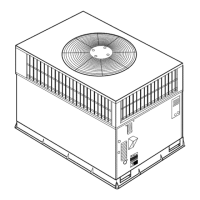Refrigerant Circuit
The refrigerant circuit is difficult to check for leaks without the prop-
er equipment. If inadequate cooling is suspected, contact your local
dealer for service.
ACCESS PANEL
FILTER ACCESS
PANEL*
*For accessory filter rack.
C99094
Fig. 6 - Accessory Filter Rack Access Panel
(Optional Louvered Panels Shown)
Fans and Fan Motors
Periodically check the condition of fan wheels and housings and
fan-motor shaft bearings. Contact your dealer for the required
annual maintenance.
Heat Exchanger
To ensure dependable and efficient heating operation, the heat
exchanger should be checked by a qualified maintenance person
before each heating season, and cleaned when necessary. This
checkout should not be attempted by anyone not having the
required expertise and equipments to properly do the job. Contact
your dealer for the required periodic maintenance.
Indoor and Outdoor Coils
Cleaning of the coils should only be done by qualified service per-
sonnel. Contact your dealer for the required annual maintenance.
Condensate Drain
The drain pan and condensate drain line should be checked and
cleaned at the same time the cooling coils are checked by your deal-
er.
Compressor
All compressors are factory shipped with a normal charge of the cor-
rect type of refrigeration grade oil. A compressor should rarely re-
quire additional oil.
Condenser Fan
PERSONAL INJURY AND UNIT DAMAGE HAZARD
Failure to follow this warning could result in personal injury,
death or property damage.
Do not insert sticks, screwdrivers, or any other object into
revolving fan blades.
The fan must be kept free of all obstructions to ensure proper cool-
ing. Contact your dealer for any required service.
Electrical Controls and Wirin_
Electrical controls are difficult to check without proper instrumenta-
tion. If there are any discrepancies in the operating cycle, contact
your local dealer and request service.
EXPLOSION AND ENVIROMENTAL HAZARD
Failure to follow this warning could result in personal injury,
death or property damage.
System under pressure. Relieve pressure and recover all
refrigerant before system repair or final unit disposal. Use all
service ports and open all flow-control devices, including
solenoid valves.
Unit Panels
After performing any maintenance or service on the unit, be sure all
panels are fastened securely in place to prevent rain from entering
unit cabinet and to prevent disruption of the correct unit airflow pat-
tern.
Combustion Area and Vent System
The combustion area and vent system should be inspected visually
before each heating season. The normal accumulation of dirt, soot,
rust, and scale can result in loss of efficiency and improper
performance if allowed to build up. this inspection should be done
by a trained service person.
Regular Dealer Maintenance
In addition to the type of routine maintenance you might be willing
to perform, your unit should be inspected regularly by a properly
trained service technician. An inspection (preferably each year, but
at least every other year) should include the following:
1. Inspection of all flue product passages-including the
burners, heat exchanger, and flue collector box.
2. Inspection of all combustion-and ventilation-air passages
and openings.
3. Close inspection of all gas pipes leading to and inside of your
unit.
4. Inspection and, if required, cleaning of the outdoor and
indoor coils.
5. Inspection and. if required, cleaning of the indoor coil
condensate drain.
6. Inspection and cleaning of blower wheel housing and motor.
7. Inspection of all supply-air and return-air ducts for leaks,
obstructions, and insulation integrity. Any problems found
should be resolved at this time.
8. Inspection of the unit base to ensure that no cracks, gaps, etc.,
exist which may cause a hazardous condition.
9. Inspection of the unit casing for signs of deterioration.
10. Inspection of all electrical wiring and components to ensure
proper connection.
11. Inspection for leaks in the refrigerant circuit. Pressure-check
to determine appropriate refrigerant charge.
12. Operational check of the unit to determine working
conditions. Repair or adjustment should be made at this time.
Your servicing dealer may offer an economical service contract that
covers seasonal inspections. Ask for further details.
Complete service instructions can be found in the unit Installation,
Start-up and Service Instructions.

